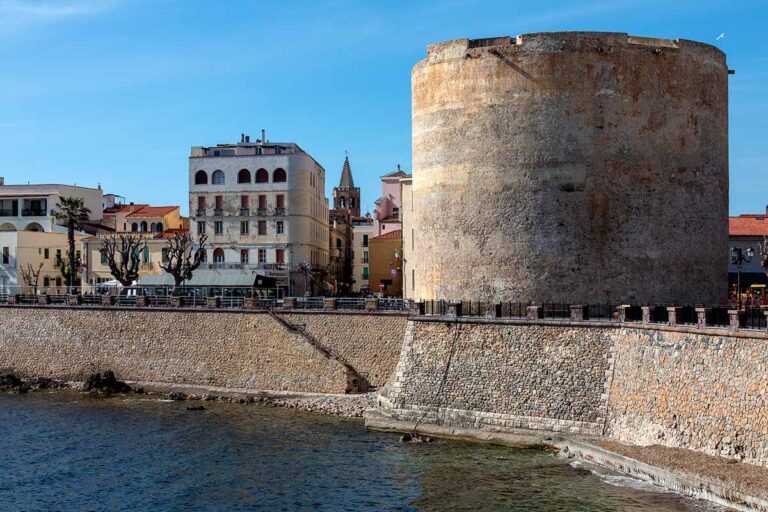Alghero
A popular tourist destination due to its beaches and historical significance, the city of Alghero is located in the island’s northwest.
The Anghelu Ruju necropolis and the Palmavera nuragic complex serve as reminders that Alghero was inhabited as early as the Neolithic era. Numerous invasions occurred there, most notably the Catalan invasion, which had an impact on its language and culture. The bastions, which are still visible today and provide a scenic stroll along the shore, are fortification buildings from the Catalan-Aragonese and Spanish periods, but some were originally completed by the Genoese Doria dynasty. The city of Alghero has a charming historic centre made up of cobbled streets and buildings of historical interest with several churches from the late medieval and modern periods.
A few miles off the shore of Alghero
The French fleet under the command of Rear Admiral Laurent Trouguet sailed off the coast of Alghero, close to the spectacular cliffs of Capo Caccia, in 1792, from Oneglia and Villafranca in the County of Nice, with the Gulf of Cagliari as its planned objective.
Cultural aristocracy
There were many intellectuals in the bustling town who shared the ideals of the Enlightenment. Among them was Giovanni Andrea Massala (1773–1817), a young man of letters whose writings include a “Giornale di Sardegna” (Journal of Sardinia) that chronicles the major events of the period and the illustrious Simon’s family.
Despite being a member of the town’s tiny aristocracy and holding the institutional post of port captain, Giuseppe’s father, Antonio Manno, a future politician, and historian, had showed support for the ‘patriotic’ movement during the 1793-96 upheavals.
A family in the Sardinian Revolution: The Simons
The Simon family is the symbol of the ‘revolution of ideas’ that resulted from the re-establishment and re-modernisation of the two Sardinian universities following Bogino’s reforms, and which deeply marked a generation of Sardinian students. Domenico, Matteo Luigi, Giovanni Francesco, and Giovanni Battista were totally immersed in the favourable impacts that flowed from that pivotal season.
The Simon brothers’ passion for Sardinia and its numerous versions was not a burden to be acquired for pure contemplative enjoyment, nor (as with other manifestations of 18th century spirits) for hazy exotic fancies. Throughout their life, the idea of ‘sardità‘, to which Simon’s studies supplied certain lineaments, could only be transfigured into political commitment.
The Simon brothers accomplished brilliant professions, yet they did not settle into the comforts of rank. Their father Bartolomeo, a Ligurian businessman who blended well into the Algherese setting, had arranged their educational path. The eldest brother, Domenico, was inspired to envision a new order to restore dignity to a land that was relegated to a marginal position in relation to the European continent by his search for sources for unravelling Sardinian history and its ancient constitutions, as well as his desire to elevate the Sardinian national language.
Dominic, as the reformist thinker of the group that suggested the five issues, was aware of the Savoys’ antagonism to any reform effort from the start, despite the fact that the Sardinians had spared the kingdom from French invasion. A talk on the establishment of a new order that motivated Matteo Luigi, an impassioned figure who accompanied Angioy to his French fate and to whom we owe the most lucid interpretation of the Sardinian Revolution. Yet neither did the more humane Gian Francesco, whose sophisticated oratory kept the Stamenti in check in 1795.
Angioy’s demise marked the end of these sophisticated representatives of the Sardinian ruling class, but we owe them a debt of gratitude for their passionate advocacy of a truth that they came to embrace. It can’t be until Sardinians are educated about the realities of their homeland, that Sardinia can be preserved and protected.
The ghostly attack
Mystery still surrounds an attack on the Catalan village. This event is reported to have involved an expeditionary force organised by Giovanni Maria Angioy during his brief stay in Sassari (spring of 1796), and the troops of the Alternos are said to have quartered on the beach of Cuguttu (not far from the present-day site known as ‘Maria Pia’) on Good Friday. Giuseppe Manno has written about this event as well. However, the narrative cannot be confirmed due to a lack of documented evidence.
Prisoners and towers
Many convicts were imprisoned in the city towers, with Vincenzo Sulis being the most well-known. Born in Cagliari in 1758, he had a carefree life until becoming a notary public and making a name for himself in the anti-French movement during the planned invasion in 1792–1793. Later, he assumed leadership of the Stampace forces during the anti-Piedmontese insurrection. An erroneous 500-scudi reward was set on him for allegedly hatching an anti-monarchist plot. After being detained and put on trial, he received a life sentence. He was first detained in the Torre dell’Aquila in Cagliari and then in the Torre dello Sperone in Alghero (that is, the Torre di Sulis). He was detained there from May 5, 1800, until July 24, 1820, when the King’s “august genetliaco” granted him an amnesty.
Salvador Roig, vicar general and administrator of the Diocese of Sassari, is also remembered: a close friend of Giommaria Angioy, he paid for his support of the ‘Sardinian Revolution’ with 16 months in exile in Alghero. During the rebellion, he distinguished himself through acts of generosity: he offered 20 bushels of wheat and 30 heads of cattle on the occasion of the French attack in 1793, he opposed the secessionist movements of the feudal lords of Sassari, and he was actively involved in attempting to eliminate feudal harassment of vassals.
Bibliography
– Bilardi, Un’inedita figura di patrizio algherese: il magistrato Giovanni Lavagna, in “Revista de l’Alguer”, Vol. 4 Num. 4 (1993), pp. 55-75
– Del Piano, Giacobini moderati e reazionari in Sardegna: saggio di un dizionario biografico 1793-1812. Mille biografie di protagonisti comprimari e testimoni del periodo rivoluzionario sardo, Cagliari, ed. Castello, 1996, ad vocem Roig
– A. Mattone, Manno Giuseppe, in Dizionario Biografico degli Italiani, Vol.69 (2007), ad vocem
– L. SIMON De la Sardigne ancienne et moderne ou Aperçu d’un voyage statistique et politique dans l’ile de Sardigne, 1813-15
– V. Sulis, Autobiografia (edizione critica a cura di Giuseppe Marci; introduzione e note storiche di Leopoldo Ortu), Cagliari, CUEC, 2004
Web bibliography
https://www.alguer.it/info/algheroneltempo/dallaconquistasabaudaalnovecento.html
Credits
M.L. Melas, A. Nasone, S. A. Tedde


